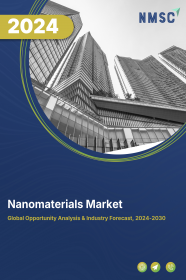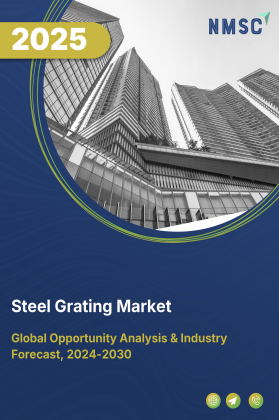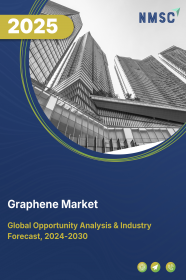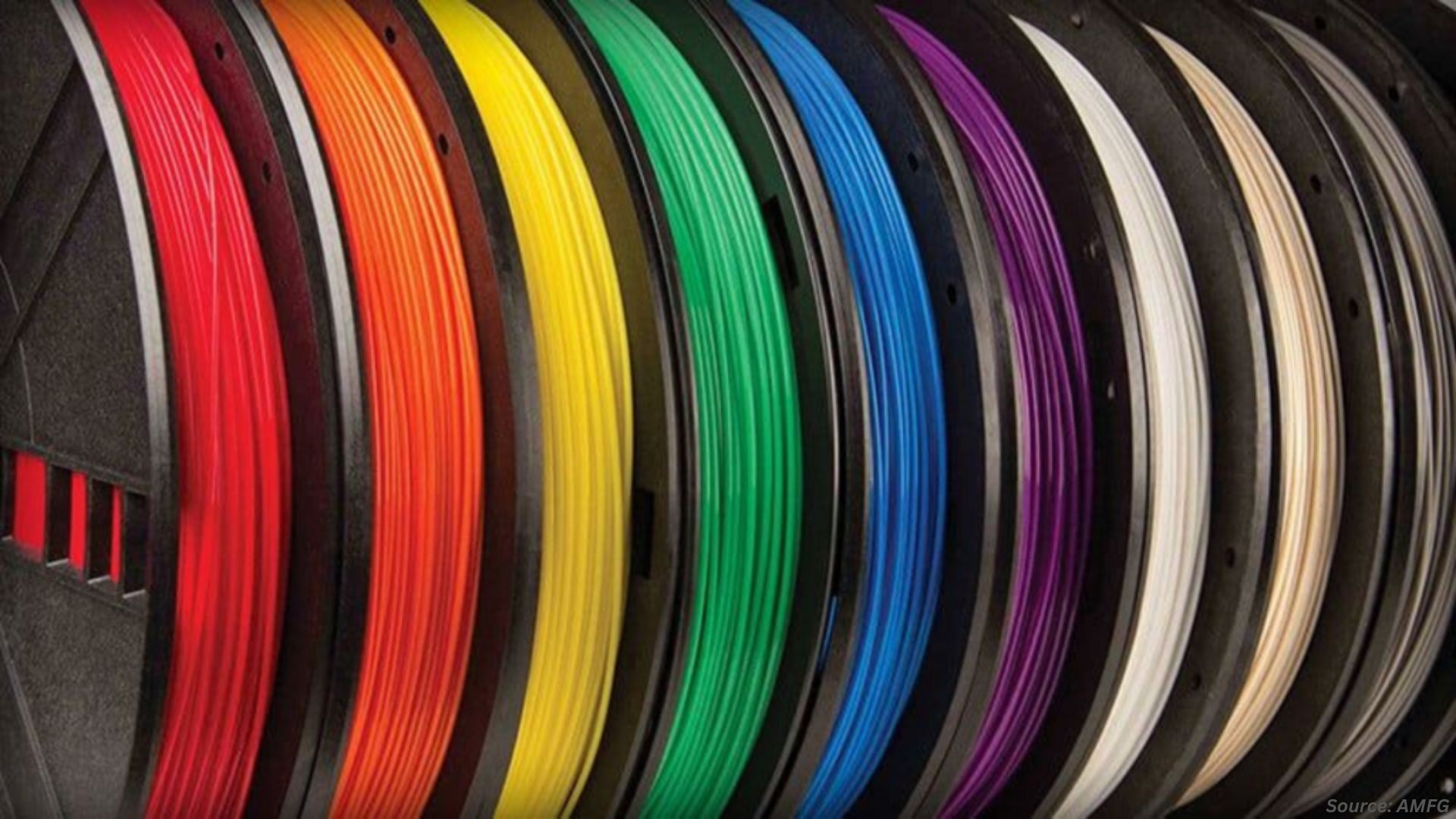
Nanomaterials Market by Product Type (Nanoparticles, Nanofibers, Nanotubes, Nanoclays, and Nanowires), by Structure Type (Non-Polymer Organic Nanomaterials and Polymeric Nanomaterials), and by End-User Industry (Aerospace, Automotive, Medical, Energy & Power, Electronics, Paints & Coatings, and Others) – Global Opportunity Analysis and Industry Forecast, 2024– 2030
Nanomaterials Market Overview
The global Nanomaterials Market size was valued at USD 15.61 billion in 2023 and is predicted to reach USD 44.48 billion by 2030 with a CAGR of 16.1% from 2024-2030. The nanomaterials market also known as nanocrystal market, refers to the production, and application of materials with structure generally ranging from 1 to 100 nanometers. These materials exhibit unique physical, chemical, and mechanical properties due to their small size and high surface area-to-volume ratio. These tiny materials find diverse applications across various industries, including electronics, medical, energy, aerospace, and automotive. In these sectors, nanocrystals enable innovations such as advanced drug delivery systems, high-performance electronics, lightweight and durable materials, and efficient energy storage solutions. With ongoing research and development efforts, the market is poised for continuous growth, offering promising opportunities for industries seeking to enhance product performance and functionality.
Market Dynamics and Trends
The worldwide increasing prevalence of human immunodeficiency virus (HIV) cases is increasing the demand for nanomaterials. These tiny materials are engineered to carry and release antiviral drugs specifically to HIV-infected cells, ensuring that the medication is delivered precisely to the affected area. According to data from the World Health Organization (WHO) in 2022, approximately 39 million individuals are living with HIV globally, with 630,000 deaths attributed to HIV-related illnesses. This ongoing rise in HIV cases highlights the urgent need for therapeutic solutions, thereby driving demand for nanocrystal in the medical sector.
Moreover, the global nanomaterials market is further driven by its increasing adoption in the automotive industry to enhance vehicle performance and efficiency. These materials are used to create lighter and stronger materials for vehicle components, improve fuel efficiency, and enhance safety features with innovative nanocomposites.
For instance, in January 2024, Kioxia Corporation launched Universal Flash Storage (UFS) Ver. 4.0 embedded flash memory devices that use nanomaterials to enhance their performance, efficiency, and reliability. These devices are designed for automotive applications, including advanced driver-assistance systems (ADAS), by leveraging the benefits of nanotechnology to deliver superior storage solutions for a range of automotive uses.
Additionally, in January 2022, Israeli start-up Nemo launched a new line of nanomaterials specifically designed for the automotive industry. These advanced materials aim to enhance vehicle performance, safety, and sustainability. As automotive manufacturers seek to meet stricter regulatory standards and consumer demands for better performance, the demand for these tiny materials continues to grow.
Also, the worldwide growing aerospace industry further drives the market by increasing demand for advanced nanocrystals including carbon nanotubes that enhance performance, efficiency, and durability of aerospace components and systems. As per the data provided by the International Trade Administration (ITA) 2024, Singapore’s aerospace industry grew at a CAGR of 8.6% over the past two decades, reaching a total annual output of more than USD 8.0 billion by 2024. Additionally, data from the Aerospace Industries Association (AIA) shows that the U.S. aerospace and defense (A&D) industry sales revenue stood at USD 952 billion in 2022. This surge in aerospace industry increases the demand for cutting-edge materials significantly boosting the nanomaterials market growth globally.
However, the high cost of producing nanomaterials is restraining the market growth by limiting their widespread adoption among small and medium sized enterprises. On the contrary, the adoption of nanotechnology including quantum dots to develop new solar cells for boosting solar cells efficiency is expected to create ample future opportunities in the nanomaterials market. For instance, in August 2023, First Solar partnered with UbiQD to explore the integration of quantum dot technology into future solar panels. This collaboration highlights the potential for significant advancements and growth in the industry.
Market Segmentations and Scope of the Study
The nanomaterials market report is segmented on the basis of product type, structure type, end-user industry, and region. On the basis of product type, the market is segmented into nanoparticles, nanofibers, nanotubes, nanoclays, and nanowires. On the basis of structure type, the market is classified into non-polymer organic nanomaterials and polymeric nanomaterials. On the basis of end-user industry, the market is distributed into aerospace, automotive, medical, energy & power, electronics, paints & coatings, and others. The regional breakdown includes regions such as North America, Europe, Asia-Pacific, and the Rest of the World (RoW).
Geographical Analysis
Asia-Pacific dominates the nanomaterials market share and is expected to continue its dominance during the forecast period. This is attributed to the increasing applications of nanocrystals in catalysis and sensors within the chemical industry. As per the data published by the European Chemical Industry Council (Cefic) in 2022, China dominates chemical sales globally, holding over 40% of global sales, that amounts to around USD 2,549 billion. As the chemical sector expands, the demand for these tiny materials is poised to surge, driven by their diverse applications as super-efficient catalysts, that make processes smoother and smarter.
Moreover, the growing adoption of nanomaterials across various sectors within the manufacturing industry, particularly in automotive, and aerospace for enhancing material properties, improving strength, and adding unique functionalities is further fueling the market in this region. As per the Indian Ministry of Statistics and Programme Implementation (MOSPI), manufacturing production in India increased by 1.20% in November 2023 compared to the same month in the previous year 2022. This growing manufacturing industry is increasing the demand for nanocrystals, contributing to the development of stronger, lighter, and more advanced products.
On the other hand, North America nanotechnology is steadily growing driven by increasing investments in research and development (R&D) that foster innovation and enable the discovery of new applications. These investments support the development of advanced nanomaterials with enhanced properties, such as greater strength, lighter weight, and improved thermal and electrical conductivity.
For example, in November 2022, the National Nanotechnology Initiative (NNI) invested in nanoscale R&D across the U.S. government. Over the past two decades, participating government agencies and departments collectively invested over USD 38 billion, aiming to realize the potential of nanoscience and position the U.S. as a leader in the field.
Also, the rising incidence of cancer cases in North America is another factor driving the market by fueling demand for advanced diagnostic and therapeutic solutions. Nanomaterials enable the development of highly sensitive diagnostic tools and targeted drug delivery systems that are crucial for early cancer detection and effective treatment. According to the data from the American Cancer Society, 1.9 million new cancer cases were diagnosed in 2022, with 609,360 cancer-related deaths in the U. S. This ongoing rise in case cases highlights the urgent need for advance diagnostic solutions, propelling the market growth.
Competitive Landscape
Various key players operating in the nanomaterials industry are ACS Material, LLC, American Elements, Arkema Group, Cabot Corporation, CHASM Advanced Materials Inc., Chengdu Organic Chemicals Co. Ltd, Jiangsu Cnano Technology Co. Ltd, LG Chem Ltd., Nano-C, Inc., Nanocyl S.A., and others. These key players continue to adopt various market development strategies including partnerships, business expansion, and launches to maintain their dominance in the market.
For instance, in March 2024, Chasm Advanced Materials, Inc. partnered with Ingevity to expand the supply of carbon nanotubes (CNTs) for the North American and European electric vehicle (EV) battery markets. The partnership allows Chasm to leverage Ingevity's manufacturing capabilities and global reach to increase the production and distribution of its CNT products.
Also, in May 2023, LG Chem announced that it started construction of its fourth carbon nanotube (CNT) plant at its Daesan Complex in South Korea. This new plant, expected to be operational by 2025, will double LG Chem's annual CNT production capacity to 6,100 tons.
Additionally, in November 2022, American Elements launched a new nanoscale electrolyte material for use in lithium-sulfur battery technology. Integrated with ceramic compound such as lithium, lanthanum, and zirconium oxide nanoparticles, the product addresses performance and safety concerns about the current generation of lithium-ion batteries.
Key Benefits
-
The report provides quantitative analysis and estimations of the nanomaterials industry from 2024 to 2030, which assists in identifying the prevailing market opportunities.
-
The study comprises a deep-dive analysis of the current and future nanomaterials market trends to depict prevalent investment pockets in the market.
-
Information related to key drivers, restraints, and opportunities and their impact on the nanomaterials trend is provided in the report.
-
Competitive analysis of the players, along with their market share is provided in the report.
-
SWOT analysis and Porters Five Forces model is elaborated in the study.
-
Value chain analysis in the market study provides a clear picture of roles of stakeholders
Nanomaterials Market Key Segments
By Product Type
-
Nanoparticles
-
Nanofibers
-
Nanotubes
-
Nanoclays
-
Nanowires
By Structure Type
-
Non-Polymer Organic Nanomaterials
-
Polymeric Nanomaterials
By End-User Industry
-
Aerospace
-
Automotive
-
Medical
-
Energy & Power
-
Electronics
-
Paints & Coatings
-
Others
By Region
-
North America
-
The U.S.
-
Canada
-
Mexico
-
-
Europe
-
The UK
-
Germany
-
France
-
Italy
-
Spain
-
Denmark
-
Netherlands
-
Finland
-
Sweden
-
Norway
-
Russia
-
Rest of Europe
-
-
Asia-Pacific
-
China
-
Japan
-
India
-
South Korea
-
Australia
-
Indonesia
-
Singapore
-
Taiwan
-
Thailand
-
Rest of Asia-Pacific
-
-
RoW
-
Latin America
-
Middle East
-
Africa
-
REPORT SCOPE AND SEGMENTATION:
|
Parameters |
Details |
|
Market Size in 2023 |
USD 15.61 Billion |
|
Revenue Forecast in 2030 |
USD 44.48 Billion |
|
Growth Rate |
CAGR of 16.1% from 2024 to 2030 |
|
Analysis Period |
2023–2030 |
|
Base Year Considered |
2023 |
|
Forecast Period |
2024–2030 |
|
Market Size Estimation |
Billion (USD) |
|
Growth Factors |
|
|
Countries Covered |
28 |
|
Companies Profiled |
10 |
|
Market Share |
Available for 10 companies |
|
Customization Scope |
Free customization (equivalent up to 80 working hours of analysts) after purchase. Addition or alteration to country, regional, and segment scope. |
|
Pricing and Purchase Options |
Avail customized purchase options to meet your exact research needs. |
KEY PLAYERS
-
ACS Material, LLC
-
American Elements
-
Arkema Group
-
Cabot Corporation
-
CHASM Advanced Materials Inc.
-
Chengdu Organic Chemicals Co. Ltd
-
Jiangsu Cnano Technology Co. Ltd
-
LG Chem Ltd.
-
Nano-C, Inc.
-
Nanocyl SA




















 Speak to Our Analyst
Speak to Our Analyst

























